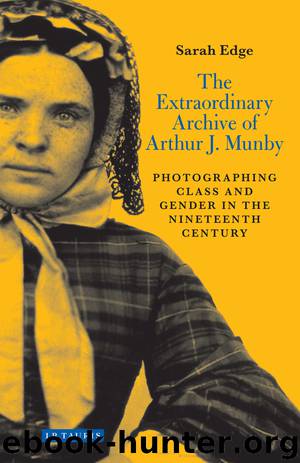The Extraordinary Archive of Arthur J. Munby by Edge Sarah

Author:Edge, Sarah.
Language: eng
Format: epub
Publisher: I.B. Tauris
Published: 2017-03-11T16:00:00+00:00
Figure 49
Once again this photograph is an ambrotype. Munby has noted on the back ‘Dustgirl Lambeth Yards. 1862’ and has also pasted an advert for ‘F. Lindsey 3 Bridge Street Lambeth’ (a business that appears to have started in 1851).
This long and detailed diary entry illustrates the complex negotiation of photographic recording that Munby was undertaking. As the more conventional flâneur, he watches the working-class woman from a distance amid the hustle and bustle of the metropolis; to replicate this in a photograph, he then ‘plucks’ her directly from this environment into the photographer’s studio and oversees the photograph being made. Through this, Munby aimed to close down the space between what he saw in the real world and what the camera recorded via its indexical action. Furthermore, by consciously selecting those ‘types’ of urban female labour already discursively constructed to bear the signs and meanings of working-classness – dress or costume, heavy labour, the visible difference of their bodies, their dirtiness and their Englishness – he can be sure that the iconic part of the photograph will fill the indexical trace with the meanings he requires. In this first phase, Munby is actively attempting to control both signifying parts of the photographic message.
However, such close control is not without anxiety: wider scholarship on dustmen confirms that their dirt/waste carried a metaphorical association of ‘pollution’ between the classes. In this context, while the woman’s dirt/waste fascinates Munby, as an authentic signifier of her lowliness and true working-classness, it also troubles him as a form of contagion and he ensures that he wears his gloves when he touches her as an unconscious double protection. Here, the gloves act as a barrier to contamination by the dirt of the working class while at the same time representing the restriction of sensitivity and touching, symbolising a removal from the material experience of the city.9
In this example, Munby’s growing confidence with the photographic process, drawn from his experience with Hannah, also allows him to arrange the woman in order to accentuate the iconic signs of class difference he wishes to be caught by the camera. He asks her to put her jacket on and to display the signs of her work with her tin dinner-can and, finally, via her pose and posture – ‘thrusting out her strong feet before her’. Only then, as Munby notes, when ‘I had posed her thus … the lens was uncovered’. Munby can displace his ‘corruption’ of photographic indexicality through manipulation, which had proved problematic in his staged photographs of Hannah, by closing down the space between the woman he sees in the material world and the photographic trace. This increasing confidence in the ability of photography to replace looking is revealed when he writes in his diary ‘this woman was’ (past tense), directing his view as the reader to his photograph and indicating that the woman in the real and the photograph of her are starting to be conflated.
It is also clear that Munby’s request for photographs of
Download
This site does not store any files on its server. We only index and link to content provided by other sites. Please contact the content providers to delete copyright contents if any and email us, we'll remove relevant links or contents immediately.
Shoot Sexy by Ryan Armbrust(17151)
Portrait Mastery in Black & White: Learn the Signature Style of a Legendary Photographer by Tim Kelly(16491)
Adobe Camera Raw For Digital Photographers Only by Rob Sheppard(16396)
Photographically Speaking: A Deeper Look at Creating Stronger Images (Eva Spring's Library) by David duChemin(16165)
Bombshells: Glamour Girls of a Lifetime by Sullivan Steve(13119)
Art Nude Photography Explained: How to Photograph and Understand Great Art Nude Images by Simon Walden(12355)
Perfect Rhythm by Jae(4628)
Pillow Thoughts by Courtney Peppernell(3414)
The Book of Joy by Dalai Lama(3234)
Good by S. Walden(2920)
The Pixar Touch by David A. Price(2744)
Fantastic Beasts: The Crimes of Grindelwald by J. K. Rowling(2550)
A Dictionary of Sociology by Unknown(2521)
Humans of New York by Brandon Stanton(2382)
Read This If You Want to Take Great Photographs by Carroll Henry(2307)
Stacked Decks by The Rotenberg Collection(2283)
On Photography by Susan Sontag(2136)
Photographic Guide to the Birds of Indonesia by Strange Morten;(2092)
Insomniac City by Bill Hayes(2087)
